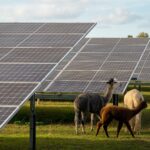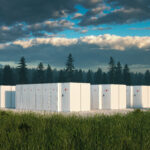Battery Energy Storage Systems (BESS): Structures that look like cargo containers that store solar-generated energy for use later. They may be located on solar farms along with panels and must be close to substations.
Decommissioning: The process of removing solar panels at the end of a property’s lease term, usually at the end of life for the solar panels. Generally, there is very little infrastructure to remove – just poles and panes, and the land reverts to its previous use. There is no danger of toxic waste or damage to soil.
Diligence Period: The period overlapping with the option term during which the developer is obtaining permitting, negotiating with the utility for the sale of power, and making sure the land has everything needed for a successful solar project.
Distributed Generation (DG): Term used for smaller projects (also called solar gardens). Usually five to fifty acres in size, these smaller projects generate one to twenty megawatts per hour to a substation that provides power to residential neighborhoods.
Gigawatt (GW): A unit of power equal to one billion watts.
Interconnection: The process of connecting a solar project to the power grid. This often happens by connecting the project to a substation or via 3 phase power lines that are in proximity to a substation. This is the essence of the agreement with the local utility agreeing to buy the power. Upgrades needed to connect the solar project to the grid are the responsibility of the developer.
Kilovolts (KV): Represents one thousand volts. Typically used when referring to the voltage of transmission lines.
Lease Term: The length of the agreement between a developer and landowner for rent of a solar project.
Megawatt (MW): A unit of power equal to one million watts, especially as a measure of the output of a power station.
Megawatt-Hour (MWh): A megawatt hour (MWh) equals a thousand kilowatts of electricity generated per hour and is used to measure electrical output. In general, megawatts are used to calculate how much a power plant generates or how much electricity is consumed by a particular area, such as a city, state, or country.
Notice to Proceed (NTP): This is the document that indicates that a project is fully entitled and ready to begin construction. This is the time when the developer takes possession of the property and begins paying rent to the landowner.
Option Premium: The funds paid to a landowner during the development timeline of a project before the project is approved – typically paid out quarterly or annually. This is the deposit that holds the land until the project is ready to launch, which can take two to four years.
Option Term: The length of an option agreement, usually estimated between two to four years. The landowner can continue to use the property for any purpose during this time and owns any cash crops that might be raised and harvested.
Photovoltaics (PV): PV materials and devices convert sunlight into electrical energy. A single PV device is known as a cell. An individual PV cell is usually small, typically producing about one or two watts of power. In order to withstand the outdoors for many years, cells are sandwiched between protective materials in a combination of glass and/or plastics. To boost the power output of PV cells, they are connected together in chains to form panels.
Power Grid: The collective term for infrastructure that transports power from one place to another, including power lines and substations.
Power Purchase Agreement (PPA): The agreement from a utility to purchase power from a solar developer at a fixed rate over the course of a longer-term contract (usually 20 years). The agreement may have shorter extensions available at the end of the initial term, as solar panels have an average lifespan of up to 40 years.
Solar Array: The panel configuration in a field for a solar project.
Substation: A station in the power grid that changes voltage from one level to another. For example, bringing power from high tension lines down to distribution lines which feed directly to homes.
3 Phase Power (3PH): Distribution lines that often have three wires and supply power directly to residences.
Transmission Scale/Utility Scale/Grid Scale: The terms for large projects (200+ acres) that feed into high tension lines to distribute larger amounts of energy over longer distances.
If you’re a landowner and interested in how these solar terms affect you, your land, and your community, please contact us. Scout Land Consultants is dedicated to simplifying the approach to lease your land for solar. Our team is happy to help you recognize your land’s potential and conduct a complimentary site evaluation.






